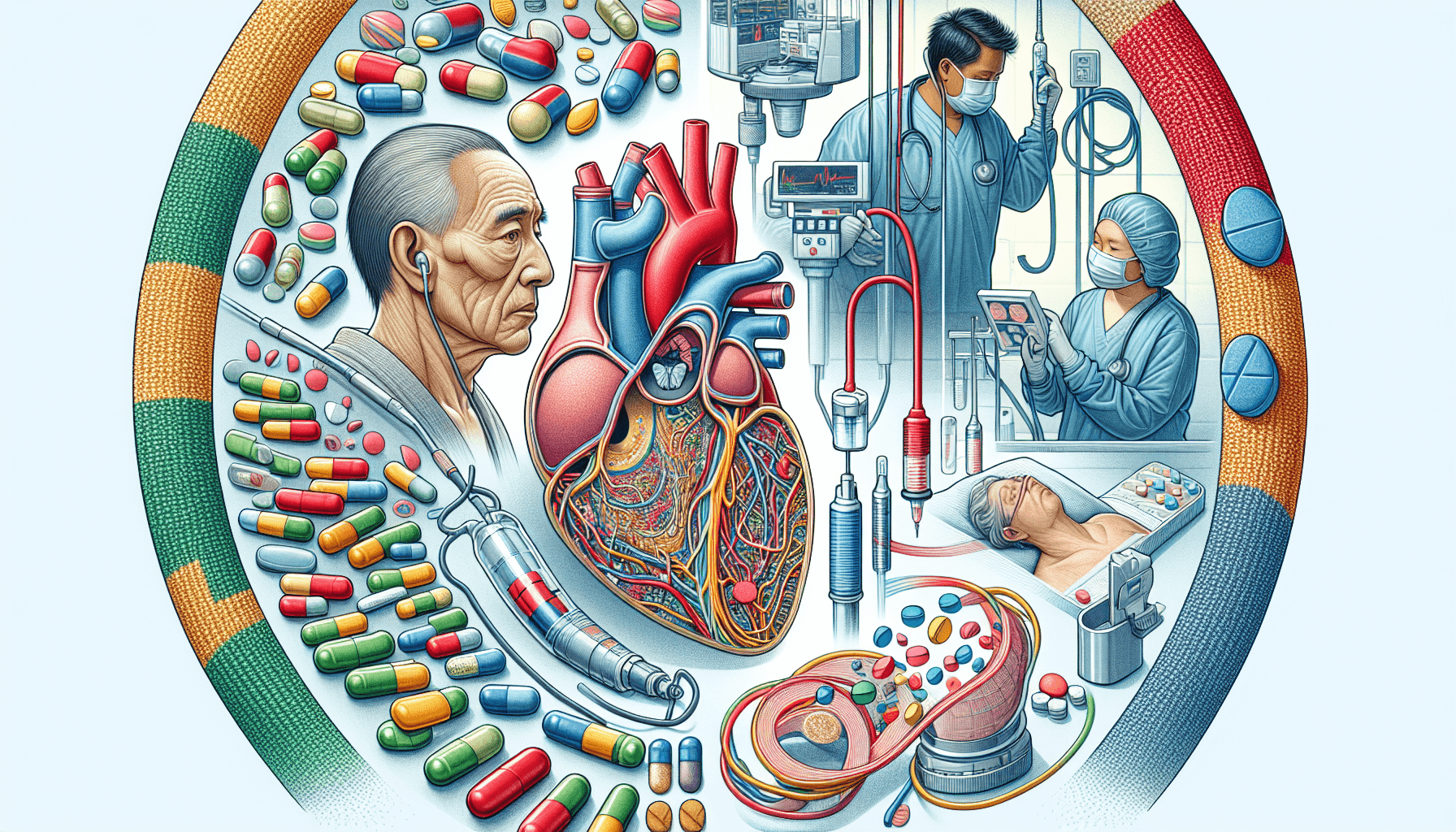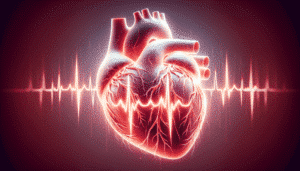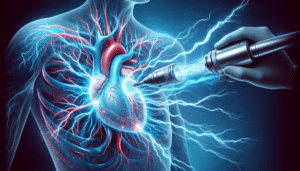Wondering if AFib can resolve itself completely? For some individuals, AFib may improve or even go into remission, particularly with appropriate treatment or lifestyle adjustments. This article provides insights into the possibility of “can afib go away” and the various factors that could influence your condition.
Key Takeaways
- Spontaneous remission of atrial fibrillation (AFib) is possible, but rare, and individuals with certain characteristics like shorter episode duration or no past history of supraventricular arrhythmias, or structural heart disease, have a higher likelihood of their heart reverting to normal rhythm without intervention.
- While treatments such as cardioversion and ablation therapy can restore normal heart rhythm in AFib, they do not guarantee permanent resolution, and recurrences of AFib are common, necessitating a multifaceted approach that may include repeat procedures, lifestyle modifications, or alternative treatments.
- Effective management of atrial fibrillation not only involves medical and non-surgical interventions but also emphasizes the importance of lifestyle changes and managing underlying conditions like high blood pressure and coronary artery disease to improve cardiovascular health and reduce the risk of AFib episodes and complications.
Exploring the Potential for Atrial Fibrillation to Resolve
Atrial fibrillation (AFib) often prompts inquiries, particularly surrounding its potential for spontaneous remission or self-resolution. While spontaneous remission is possible, it’s not common, and complete resolution without recurrence is even rarer. So, what does this mean for those with AFib? It highlights the importance of ongoing treatment in managing this condition.
Medical intervention significantly aids in resolving AFib. Procedures like cardioversion and ablation therapy can potentially restore the heart’s rhythm, ending an AFib episode. However, these treatments don’t guarantee a complete cure, and AFib may reoccur. The journey towards resolving AFib, as you may have begun to realize, can be complex and multifaceted.
Is Spontaneous Remission Possible?
Many grappling with AFib often ponder, “Can AFib just dissipate?” While spontaneous remission of AFib, where the heart reverts to normal rhythm without medical intervention, can occur, it’s not a common phenomenon. Certain factors, however, might increase this likelihood.
Patients with shorter AFib episodes, typically less than 24 or 48 hours, and with normal left atrial dimensions are more likely to spontaneously revert to sinus rhythm. This was observed in emergency departments where patients with recent-onset atrial fibrillation spontaneously reverted to sinus rhythm over a sufficiently long observation period. Identifying patients with a high chance of spontaneous conversion could decrease the need for acute interventions and potentially reduce healthcare costs.
But what ensues when spontaneous remission falls through?
The Role of Treatment in Ending AFib
Treatment is a pivotal component in managing AFib for numerous individuals. One such intervention is atrial fibrillation ablation, a procedure that uses heat or cold to create strategic scars in the heart tissues. These strategic scars block faulty electrical signals, helping restore normal heart rhythm. Ablation may be considered if medications or other treatments prove ineffective or, in some cases, it may also be the initial treatment choice.
Nevertheless, it is key to realize that ablation, despite its ability to restore normal rhythm and alleviate symptoms, doesn’t always guarantee full recovery or remission. Some individuals may experience a recurrence of irregular heartbeats after the procedure, leading to the need for repeat procedures, chronic medical therapy, or alternative treatments. Therefore, while treatment plays a key role in ending AFib, managing this condition often requires a multifaceted approach.
Understanding Atrial Fibrillation: More Than Just an Irregular Heartbeat

Atrial fibrillation (AFib) extends beyond being just an irregular heartbeat. The condition is defined by disorganized electrical signals that result in a fast and irregular heart rhythm. This can lead to complications if not managed effectively. The SA node maintains the normal heart rhythm by directing the timing of electrical impulses, ensuring the heart pumps smoothly. Its role is crucial in keeping the heart’s rhythm in check and ensuring efficient circulation throughout the body. However, in AFib, the heart’s electrical system fails. The steady heartbeat from the SA node is replaced by multiple, erratic atrial fibrillation signals.
This disruption in the heart’s electrical system leads to variations in the amount of blood pumped out of the ventricles to the body. The randomness of atrial beats during AFib results in abnormal electrical activity within the atria, leading to fibrillation. This is often associated with a fast heart rate, classified as a tachyarrhythmia. While AFib is indeed an irregular heartbeat, it’s clear that its impact on the heart – and the individual – is far more wide-reaching.
Types of AFib: Paroxysmal, Persistent, and Long-Standing
Atrial fibrillation is not a one-size-fits-all condition. In fact, it can be classified into three types:
- Paroxysmal atrial fibrillation – characterized by episodes that come and go on their own within 7 days
- Persistent atrial fibrillation – episodes that last longer than 7 days and require medical intervention to restore normal heart rhythm
- Long-standing – continuous atrial fibrillation that lasts for more than a year
This categorization helps healthcare providers tailor treatment strategies to the specific needs of each individual.
Each type presents its unique challenges, emphasizing the importance of personalized care in managing AFib. In general, paroxysmal atrial fibrillation is an earlier stage of atrial fibrillation, with less permanent heart damage or fibrosis when compared to other stages of AFib. AS a result, paroxysmal atrial fibrillation responds better to treatment then more persistent forms of AFib.
The Importance of Managing Risk Factors
Comprehending AFib is as essential as recognizing and managing risk factors like high blood pressure and coronary artery disease, which can exacerbate this condition. These factors can lead to long-term damage of heart tissue and alter electrical impulses, further complicating the course of AFib.
Effectively managing these risk factors can improve overall cardiovascular health and reduce the risk of developing atrial fibrillation. It’s crucial to note that the management of these risk factors often involves not only medication adherence but also lifestyle adjustments, guided by healthcare professionals.
For a clearer understanding, let’s dive into the lifestyle factors and underlying heart conditions that sway AFib.
Lifestyle Factors That Influence AFib
Lifestyle decisions profoundly affect the management and risk of developing atrial fibrillation. From our diet to our daily habits, each choice we make can either help in managing AFib or heighten its severity. For instance, controlling caffeine and alcohol intake can lower the chances of arrhythmia symptoms as caffeine can accelerate heart rate and alcohol may increase blood pressure.
Moreover, to reduce the symptoms related to atrial fibrillation, it is recommended to:
- Quit smoking or the use of tobacco products
- Use over-the-counter cough and cold medicines with caution, as some may induce an arrhythmia
- Incorporate strategies to manage stress, such as therapy, breathing exercises, yoga, or acupuncture, to help reduce blood pressure and triggering of AFib.
Regular physical activity, such as a daily 30-minute walk, is beneficial for weight loss, lowering high blood pressure, and decreasing the risk of arrhythmia.
The Impact of Underlying Heart Conditions
Despite the importance of lifestyle factors, the role of underlying heart conditions in resolving and managing AFib should not be ignored. Individuals without heart failure, and without significant valvular heart disease, or other underlying heart conditions are more likely to experience spontaneous resolution of atrial fibrillation. Thus, the absence of underlying heart disease affects the spontaneous conversion to a normal heart rhythm in AFib patients.
Underlying heart conditions can lead to cardiac remodeling, causing structural and electrical changes in the heart that perpetuate arrhythmias in patients with atrial fibrillation. Furthermore, AFib can cause heart failure by preventing the heart from adequately filling with blood, compromising its ability to pump effectively to the rest of the body. Patients with persistent or long-standing non-paroxysmal AFib, who usually have more comorbidities, face a higher risk of stroke and systemic embolization, underscoring the impact of underlying heart conditions.
Treatment Strategies to Address AFib

There exist various treatment strategies for managing AFib. AFib causes blood flow in the heart to become turbulent, increasing the chance of clot formation. Therefore, preventing blood clots in AFib patients is crucial as they are at an increased risk of stroke due to this turbulent blood flow.
Let’s now explore specific treatment strategies, beginning with medications.
Medications as a Line of Defense
Medications are the primary defense against AFib. Some common medications used to treat AFib include:
- Blood thinners, such as warfarin, dabigatran, rivaroxaban, apixaban, and edoxaban, which are crucial in preventing strokes in AFib patients by preventing clot formation.
- Antiarrhythmic medications, which help to control the heart’s rhythm. These medications can include flecainide, sotalol, and amiodarone to name a few.
- Diuretic medications, which help to reduce fluid buildup in the body.
Depending on the individual’s condition, a combination of these medications may be used. It is important to discuss with your healthcare provider the best medication regimen for you.
While medications are beneficial, they come with their own set of risks. For instance, there are risks associated with anticoagulants, including bleeding events that can be serious and demand immediate medical attention. Therefore, patients should always be aware of the signs and stay in close contact with their healthcare provider.
Procedure Treatments for AFib
Procedures like radiofrequency ablation and catheter ablation are minimally invasive treatment options for cardiac arrhythmias. Alternatively, cryoablation, which involves freezing areas of heart tissue, can also be used to control atrial fibrillation. In these procedures, problematic heart tissue is destroyed with energy delivered through a catheter, aiding the heart to return to a normal rhythm.
However, it should be noted that even though ablation curtails atrial fibrillation symptoms, it doesn’t nullify the stroke risk. Hence, patients may need to continue on blood thinners even after the procedure.
When Surgery Might Be Necessary
For certain individuals with atrial fibrillation, particularly those concurrently undergoing surgery for other heart conditions, such as valve replacement or coronary bypass surgery, open-heart surgery might be requisite. During such surgeries, the maze procedure or mini maze procedure, an intervention specifically for treating atrial fibrillation, can be performed simultaneously.
While the thought of open-heart surgery can be daunting, it’s comforting to know that it’s usually considered only when other treatment options have been exhausted or are not suitable for those at risk of a heart attack.
Recognizing and Responding to Symptoms of Atrial Fibrillation

Identifying the symptoms of atrial fibrillation is fundamental for prompt response and medical consultation. Symptoms to monitor for atrial fibrillation include:
- Irregular or rapid heartbeat
- Palpitations, which can feel like flip-flopping, fluttering, or the rapid onset of a fast heartbeat
- Shortness of breath, especially during rest or simple activities
If you experience any of these symptoms, it is important to seek medical attention.
Persistent fatigue or weakness may signal atrial fibrillation due to the heart pumping inefficiently and compromising the blood supply to the body. Symptoms of atrial fibrillation that occur at night, such as heavy breathing while asleep or night sweats, should prompt a discussion with a healthcare provider. Seek immediate medical help if the symptoms are severe, such as experiencing a rapid onset of a very fast heartbeat, which could indicate a more urgent cardiovascular problem.
Preventive Measures to Avoid AFib Episodes
Managing AFib isn’t solely about identifying symptoms and pursuing treatment, but also entails adopting preventive measures to curtail the chances of AFib episodes. Implementing lifestyle changes such as:
- managing weight
- engaging in regular physical activity
- moderating alcohol intake
- avoiding smoking
can help in managing this condition.
In addition to these lifestyle modifications, it’s also important to learn to identify and avoid individual triggers for AFib, such as:
- stress
- excessive alcohol consumption
- caffeine
- foods with MSG
Adhering to a heart-healthy Mediterranean-style diet rich in plant-based foods and low in saturated fats can also help prevent atrial fibrillation episodes.
Moreover, managing sleep apnea, a condition often linked to AFib, can alleviate AFib symptoms.
Summary
Atrial fibrillation is a complex condition that affects millions of individuals worldwide. It’s crucial to understand that AFib is more than just an irregular heartbeat – it’s a condition that can impact the overall quality of life. From recognizing the potential for spontaneous remission to exploring various treatment strategies, understanding AFib can empower individuals to take proactive steps in managing this condition. Remember, while AFib may be a storm in the heart, with knowledge, timely intervention, and lifestyle modifications, it’s a storm that can be navigated.
Frequently Asked Questions
How do I get my AFib back to normal?
You can consider treatment options such as medication (beta-blockers, blood thinners, calcium channel blockers), catheter ablation, or electrical cardioversion to treat persistent AFib and restore normal heart rhythm. Afterward, medication is usually prescribed to prevent the irregular heart rhythm from recurring.
Can you live long with atrial fibrillation?
With proper treatment, people with atrial fibrillation can often lead long, healthy lives. It can lower life expectancy without treatment, but with proper care, living long is possible.
Can atrial fibrillation reversed?
Atrial fibrillation can be successfully reversed with medication or procedures, and lifestyle changes can also help reduce the risk. Treatments include medications, cardioversion, ablation, and adopting a healthy lifestyle.
How can I calm my atrial fibrillation naturally?
To calm atrial fibrillation naturally, you can try deep, mindful breathing, exercise, the Valsalva maneuver, yoga, and applying cold water to your face. It’s important to contact a health professional for further guidance and support.
Can your heart get out of AFib on its own?
Paroxysmal AFib can stop on its own within a week, while long-standing persistent AFib may require treatment to correct the rhythm. (Avoid excessive details to keep the message clear and direct.)
The Best Atrial Fibrillation Book
Your Complete Guide To AFib: The Essential Manual For Every Patient With Atrial Fibrillation
$15.95 (as of May 27, 2025 13:40 GMT -06:00 - More infoProduct prices and availability are accurate as of the date/time indicated and are subject to change. Any price and availability information displayed on [relevant Amazon Site(s), as applicable] at the time of purchase will apply to the purchase of this product.) The A to Z guide on everything you need to know about atrial fibrillation. Written by AFib expert Dr. Percy Morales MD. Over 120 pages of essential information on medications, procedures, and lifestyles modifications for AFib. Easy to read for every patient.
Shop AFib Products on Amazon
KardiaMobile 6-Lead Personal EKG Monitor – Six Views of The Heart – Detects AFib and Irregular Arrhythmias – Instant Results in 30 Seconds – Works with Most Smartphones - FSA/HSA Eligible
13% Off
KardiaMobile 1-Lead Personal EKG Monitor – Record EKGs at Home – Detects AFib and Irregular Arrhythmias – Instant Results in 30 Seconds – Easy to Use – Works with Most Smartphones - FSA/HSA Eligible
$79.00 (as of May 27, 2025 13:40 GMT -06:00 - More infoProduct prices and availability are accurate as of the date/time indicated and are subject to change. Any price and availability information displayed on [relevant Amazon Site(s), as applicable] at the time of purchase will apply to the purchase of this product.)
Apple Watch Series 9 [GPS 41mm] Smartwatch with Storm Blue Aluminum Case with Silver Sport Band M/L. Fitness Tracker, Blood Oxygen & ECG Apps, Always-On Retina Display
(as of May 27, 2025 06:39 GMT -06:00 - More infoProduct prices and availability are accurate as of the date/time indicated and are subject to change. Any price and availability information displayed on [relevant Amazon Site(s), as applicable] at the time of purchase will apply to the purchase of this product.)
Fitbit Sense 2 Advanced Health and Fitness Smartwatch with Tools to Manage Stress and Sleep, ECG App, SpO2, 24/7 Heart Rate and GPS, Shadow Grey/Graphite, One Size (S & L Bands Included)

OMRON 2-in-1 Upper Arm Blood Pressure Monitor & 1-Lead EKG Monitor - Clinically Validated Blood Pressure Arm Cuff & Machine - Use OMRON Connect App
17% Off
Samsung Galaxy Watch 6 44mm Bluetooth Smartwatch, Fitness Tracker, Personalized HR Zones, Advanced Sleep Coaching, Heart Monitor, BIA Sensor, Health Wellness Insights, Big Screen, US Version, Graphite
51% Off $329.99 (as of May 27, 2025 19:00 GMT -06:00 - More infoProduct prices and availability are accurate as of the date/time indicated and are subject to change. Any price and availability information displayed on [relevant Amazon Site(s), as applicable] at the time of purchase will apply to the purchase of this product.)
Natural Rhythm Triple Calm Magnesium 150 mg - 120 Capsules – Magnesium Complex Compound Supplement with Magnesium Glycinate, Malate, and Taurate. Calming Blend for Promoting Rest and Relaxation.
$20.77 ($0.17 / Count) (as of May 27, 2025 15:17 GMT -06:00 - More infoProduct prices and availability are accurate as of the date/time indicated and are subject to change. Any price and availability information displayed on [relevant Amazon Site(s), as applicable] at the time of purchase will apply to the purchase of this product.)
Pure Encapsulations Magnesium (Glycinate) - Supplement to Support Stress Relief, Sleep, Heart Health, Nerves, Muscles, and Metabolism* - with Magnesium Glycinate - 180 Capsules
$44.60 ($0.25 / Count) (as of May 27, 2025 06:44 GMT -06:00 - More infoProduct prices and availability are accurate as of the date/time indicated and are subject to change. Any price and availability information displayed on [relevant Amazon Site(s), as applicable] at the time of purchase will apply to the purchase of this product.)















![Apple Watch Series 9 [GPS 41mm] Smartwatch with Storm Blue Aluminum Case with Silver Sport Band M/L. Fitness Tracker, Blood Oxygen & ECG Apps, Always-On Retina Display #1](https://m.media-amazon.com/images/I/311xwtp4mFL._SL100_.jpg)
![Apple Watch Series 9 [GPS 41mm] Smartwatch with Storm Blue Aluminum Case with Silver Sport Band M/L. Fitness Tracker, Blood Oxygen & ECG Apps, Always-On Retina Display #2](https://m.media-amazon.com/images/I/41j+8AaUGsL._SL100_.jpg)
![Apple Watch Series 9 [GPS 41mm] Smartwatch with Storm Blue Aluminum Case with Silver Sport Band M/L. Fitness Tracker, Blood Oxygen & ECG Apps, Always-On Retina Display #3](https://m.media-amazon.com/images/I/41jIyxZitnL._SL100_.jpg)
![Apple Watch Series 9 [GPS 41mm] Smartwatch with Storm Blue Aluminum Case with Silver Sport Band M/L. Fitness Tracker, Blood Oxygen & ECG Apps, Always-On Retina Display #4](https://m.media-amazon.com/images/I/41IpNJERjCL._SL100_.jpg)
![Apple Watch Series 9 [GPS 41mm] Smartwatch with Storm Blue Aluminum Case with Silver Sport Band M/L. Fitness Tracker, Blood Oxygen & ECG Apps, Always-On Retina Display #5](https://m.media-amazon.com/images/I/31o17yhfYpL._SL100_.jpg)






































